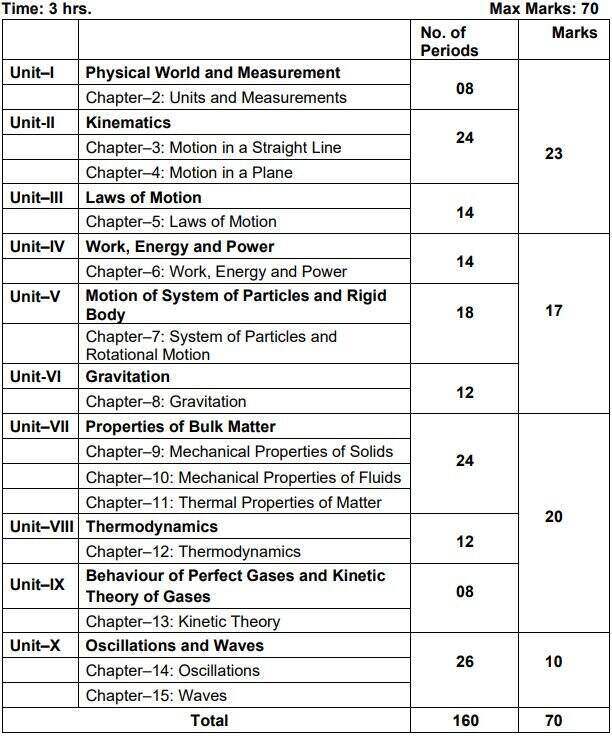CBSE Class 11 Physics Syllabus 2022-2023 is provided here in PDF format. Download the revised syllabus to know the course content to be prepared for CBSE Class 11 Physics Annual Exam 2022-2023.

CBSE Class 11 Physics Syllabus 2022-2023 can be downloaded in PDF from the link mentioned below in this article. The Central Board of Secondary Education (CBSE) has revised the syllabus for the current academic session. The Physics syllabus has been prepared according to the annual scheme of assessment. Students must go through the full syllabus and study Physics as per the content mentioned in it.
Check CBSE Class 11 Physics Syllabus 2022-23 below:

Unit I: Physical World and Measurement 08 Periods
Chapter–2: Units and Measurements
Need for measurement: Units of measurement; systems of units; SI units, fundamental and derived units. significant figures. Dimensions of physical quantities, dimensional analysis and its applications.
Unit II: Kinematics 24 Periods
Chapter–3: Motion in a Straight Line
Frame of reference, Motion in a straight line, Elementary concepts of differentiation and integration for describing motion, uniform and non- uniform motion, and instantaneous velocity, uniformly accelerated motion, velocity - time and position-time graphs. Relations for uniformly accelerated motion (graphical treatment).
Chapter–4: Motion in a Plane
Scalar and vector quantities; position and displacement vectors, general vectors and their notations; equality of vectors, multiplication of vectors by a real number; addition and subtraction of vectors, Unit vector; resolution of a vector in a plane, rectangular components, Scalar and Vector product of vectors. Motion in a plane, cases of uniform velocity and uniform acceleration projectile motion, uniform circular motion.
Unit III: Laws of Motion 14 Periods
Chapter–5: Laws of Motion
Intuitive concept of force, Inertia, Newton's first law of motion; momentum and Newton's second law of motion; impulse; Newton's third law of motion. Law of conservation of linear momentum and its applications. Equilibrium of concurrent forces, Static and kinetic friction, laws of friction, rolling friction, lubrication.
Dynamics of uniform circular motion: Centripetal force, examples of circular motion (vehicle on a level circular road, vehicle on a banked road).
Unit IV: Work, Energy and Power 14 Periods
Chapter–6: Work, Energy and Power
Work done by a constant force and a variable force; kinetic energy, workenergy theorem, power. Notion of potential energy, potential energy of a spring, conservative forces: non- conservative forces, motion in a vertical circle; elastic and inelastic collisions in one and two dimensions.
Unit V: Motion of System of Particles and Rigid Body 18 Periods
Chapter–7: System of Particles and Rotational Motion
Centre of mass of a two-particle system, momentum conservation and Centre of mass motion. Centre of mass of a rigid body; centre of mass of a uniform rod. Moment of a force, torque, angular momentum, law of conservation of angular momentum and its applications. Equilibrium of rigid bodies, rigid body rotation and equations of rotational motion, comparison of linear and rotational motions. Moment of inertia, radius of gyration, values of moments of inertia for simple geometrical objects (no derivation).
Unit VI: Gravitation 12 Periods
Chapter–8: Gravitation
Kepler's laws of planetary motion, universal law of gravitation. Acceleration due to gravity and its variation with altitude and depth. Gravitational potential energy and gravitational potential, escape velocity, orbital velocity of a satellite.
Unit VII: Properties of Bulk Matter 24 Periods
Chapter–9: Mechanical Properties of Solids
Elasticity, Stress-strain relationship, Hooke's law, Young’s modulus, bulk modulus, shear modulus of rigidity (qualitative idea only), Poisson's ratio; elastic energy.
Chapter–10: Mechanical Properties of Fluids
Pressure due to a fluid column; Pascal's law and its applications (hydraulic lift and hydraulic brakes), effect of gravity on fluid pressure. Viscosity, Stokes' law, terminal velocity, streamline and turbulent flow, critical velocity, Bernoulli's theorem and its simple applications. Surface energy and surface tension, angle of contact, excess of pressure across a curved surface, application of surface tension ideas to drops, bubbles and capillary rise.
Chapter–11: Thermal Properties of Matter
Heat, temperature, thermal expansion; thermal expansion of solids, liquids and gases, anomalous expansion of water; specific heat capacity; Cp, Cv - calorimetry; change of state - latent heat capacity. Heat transfer-conduction, convection and radiation, thermal conductivity, qualitative ideas of Blackbody radiation, Wein's displacement Law, Stefan's law .
Unit VIII: Thermodynamics 12 Periods
Chapter–12: Thermodynamics
Thermal equilibrium and definition of temperature zeroth law of thermodynamics, heat, work and internal energy. First law of thermodynamics, Second law of thermodynamics: gaseous state of matter, change of condition of gaseous state -isothermal, adiabatic, reversible, irreversible, and cyclic processes.
Unit IX: Behavior of Perfect Gases and Kinetic Theory of Gases 08 Periods
Chapter–13: Kinetic Theory
Equation of state of a perfect gas, work done in compressing a gas. Kinetic theory of gases - assumptions, concept of pressure. Kinetic interpretation of temperature; rms speed of gas molecules; degrees of freedom, law of equi-partition of energy (statement only) and application to specific heat capacities of gases; concept of mean free path, Avogadro's number.
Unit X: Oscillations and Waves 26 Periods
Chapter–14: Oscillations
Periodic motion - time period, frequency, displacement as a function of time, periodic functions and their application. Simple harmonic motion (S.H.M) and its equations of motion; phase; oscillations of a loaded spring- restoring force and force constant; energy in S.H.M. Kinetic and potential energies; simple pendulum derivation of expression for its time period.
Chapter–15: Waves
Wave motion: Transverse and longitudinal waves, speed of travelling wave, displacement relation for a progressive wave, principle of superposition of waves, reflection of waves, standing waves in strings and organ pipes, fundamental mode and harmonics, Beats.
Students may also download the full syllabus in PDF from the following link:
click to begin